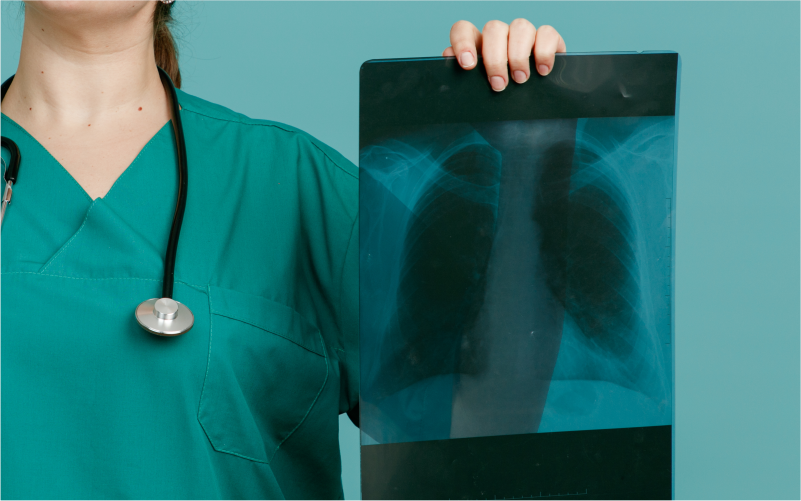Introduction
Bronchiectasis is when the walls of your bronchi, the tubes that carry air into and out of your lungs, become thickened and damaged. This makes it harder to breathe. You could have flare-ups of severe breathing problems (your doctor may call them exacerbations) from time to time. Bronchiectasis is a long-term (or chronic) disease that gets worse over time. There’s no cure, but you can live with it for a long time.TX Hospitals have the best doctors for bronchiectasis treatment in Hyderabad.

Bronchiectasis Symptoms
Coughing and shortness of breath are common symptoms of bronchiectasis. Others include:
- Coughing up phlegm or blood
- Chills or night sweats
- Fatigue
- Weight loss
- Chest pain
- Thicker skin under your fingernails and toenails (clubbing)
- Wheezing or a whistling sound when you breathe
- Frequent respiratory infections
Bronchiectasis Causes
Your bronchial walls can slowly get thicker because of inflammation and infections. Both of these things keep mucus from draining the way it should.
That extra mucus can trap bacteria, causing more infections, scarring, and thickening. Over time, your lungs have to work harder to breathe.
Acid reflux into your lungs, like with gastroesophageal reflux disease (GERD), May also damage them.
Bronchiectasis Risk Factors:
Younger people don’t usually get bronchiectasis. Less than 1 in 20,000 people ages 18 to 34 have it. But that number goes up to about 1 in every 350 people who are 75 or older.
Two-thirds of bronchiectasis cases are in women. But it’s more common in young boys than in girls.
You’re more likely to get it if you have:
- Lung infections that are severe or keep coming back, like pneumonia, tuberculosis, or whooping cough (pertussis)
- Allergic bronchopulmonary aspergillosis, a type of lung inflammation caused by a fungus
- Alpha-1-antitrypsin deficiency, which raises your risk of lung and liver diseases
Cystic fibrosis, a disease that’s tied to your genes and damages your lungs, digestive system, and other organs Conditions that affect the cilia, small hair-like growths that clear mucus out of your bronchi Immunodeficiency diseases such as HIV or AIDS Inflammatory bowel diseases, like Crohn’s disease and ulcerative colitis Low levels of proteins that fight infections in your blood (humoral immunodeficiency) Rheumatic diseases, like rheumatoid arthritis and Sjogren’s syndrome Chronic pulmonary aspiration, when you accidentally inhale things like food or liquids Breathing in things that damage your airways like gases, smoke, or coal dust.
Bronchiectasis Diagnosis
See your doctor if you have symptoms of bronchiectasis, especially if you’ve had them for a while. They’ll probably order tests including:
- A chest X-ray and CT scan to make images of your lungs
- Blood tests to check for infections
- Pulmonary function tests to measure how well you’re breathing
- Tests of material that you cough up from your lungs, called sputum, which may have bacteria in it
- A sweat test to look for cystic fibrosis
- Bronchoscopy, in which your doctor uses a thin, flexible tube called a bronchoscope to look inside your airways
Bronchiectasis Treatment
Because bronchiectasis gets worse over time, it’s important to catch and treat it early. That will prevent infections, slow damage, and make your symptoms easier to manage.
Depending on your case, treatment for bronchiectasis can include:
Medications: You’ll probably get antibiotics to fight infections. One type, called macrolides (examples are azithromycin and clarithromycin), eases inflammation. Inhaled corticosteroids can also treat inflammation in your airways. Your doctor may prescribe medicine to thin mucus or help you cough it up (called expectorants). They might also give you an inhaler or a machine called a nebulizer to breathe in bronchodilators, drugs that open your airways.
Vaccines: Your doctor will probably suggest that you get COVID, flu and pneumonia vaccinations to keep certain infections at bay.
Oxygen therapy and chest physical therapy: They may also suggest oxygen therapy or methods and devices to shake mucus free. These treatments are known as chest physical therapy (CPT), chest clapping, or percussion. They can include physically pounding on your chest to clear your bronchi and lungs, or wearing an inflatable vest that uses air waves to force mucus up.
Surgery: In severe cases, you might need to have surgery or a lung transplant.
Bronchiectasis Prevention
Some steps help prevent the infections and tissue damage that can lead to bronchiectasis.
- Get treatment for any lung infection as soon as possible.
- If you smoke, quit.
- Make sure children get recommended vaccinations for illnesses like whooping cough and measles.
- Keep an eye on small children to keep them from putting things in their mouth. Get help right away if someone’s airways are blocked.
- Avoid things that can damage your lungs, like smoke and chemicals.







